Juicy inari age made with 4 ingredients and no refined sugar! Sweet-savory deep-fried tofu pockets for inari sushi, kitsune udon, and more.

Inari age is made by simmering aburaage (deep-fried tofu pockets and deep-fried bean curd) in a sweet and savory broth, and it’s one of my favorite things to meal prep.
You can use it in all kinds of dishes—inari sushi, kitsune udon, mixed rice, or even salads.
It’s usually made with sugar, but I use maple syrup instead to keep it a little healthier (I’m trying to cut back on refined sugar!).
Why You'll Love This Recipe
- No Refined Sugar: Inari age is usually made with sugar, but I use maple syrup instead to keep it free of refined sugar. It gives a mild, natural sweetness that I really love.
- Just 4 Ingredients: Yep, you only need four ingredients to make these delicious inari age! And the best part? They're simple and easy to find, even if you're in the States.
- Juicy and Flavorful: We’ll simmer the aburaage (deep-fried tofu pockets) in sweet-savory broth until they soak up all the flavor. The result? A perfect balance of sweetness, saltiness, and umami from the dashi and aburaage. So juicy and satisfying!
- Easy to Make: Some parts might take a little time, like opening each tofu pocket or gently squeezing them, but the steps are simple and totally doable, even if you’re new to Japanese cooking.
Notes on Ingredients
See the recipe card for the full ingredients list.
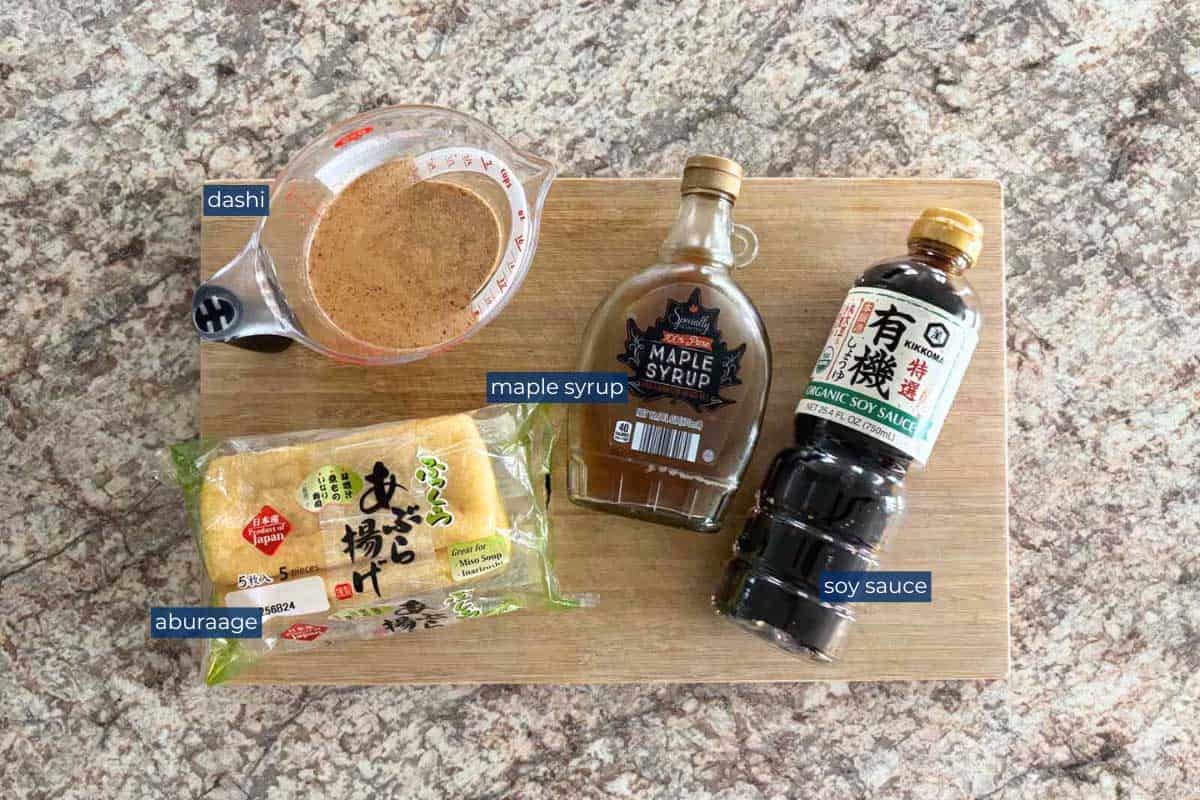
- Aburaage (deep-fried tofu pouch/pocket): Aburaage are deep-fried tofu pockets, found at most Asian grocery stores. I usually order mine from Weee! (online Asian grocery store) since my local stores don’t carry them. You can make them from scratch, but I’ve heard it’s really tricky and I haven’t tried it myself!
- Dashi: You can use regular liquid dashi, or just mix 1 cup of water with 1 teaspoon of dashi powder (like Kayanoya Dashi) to make your own quick version. Use kombu dashi for a vegan/vegetarian version.
- Soy sauce: Use koikuchi soy sauce for this recipe to add a nice dark color and depth of umami.
An Important Cooking Tool to Make Inari Age
You’ll need a Japanese cooking tool called an otoshi buta to make inari age. It’s a drop lid that helps keep ingredients from moving around too much so they hold their shape and cook evenly in the seasoning. In this recipe, it also helps press the aburaage down so they soak up more of the broth.
If you don’t have an otoshi buta, you can find one at some asian grocery stores or online (Amazon usually has them).
Or, you can make a quick DIY version using baking paper: just cut it into a circle slightly smaller than your pot, poke a few small holes to let steam escape, and place it directly on top of the ingredients.
If you’re using baking paper instead of an otoshi buta, you won’t be able to press it down the same way. In that case, you can place a small plate on top of the baking paper otoshi buta to help push the aburaage down.
How to Make Inari Age
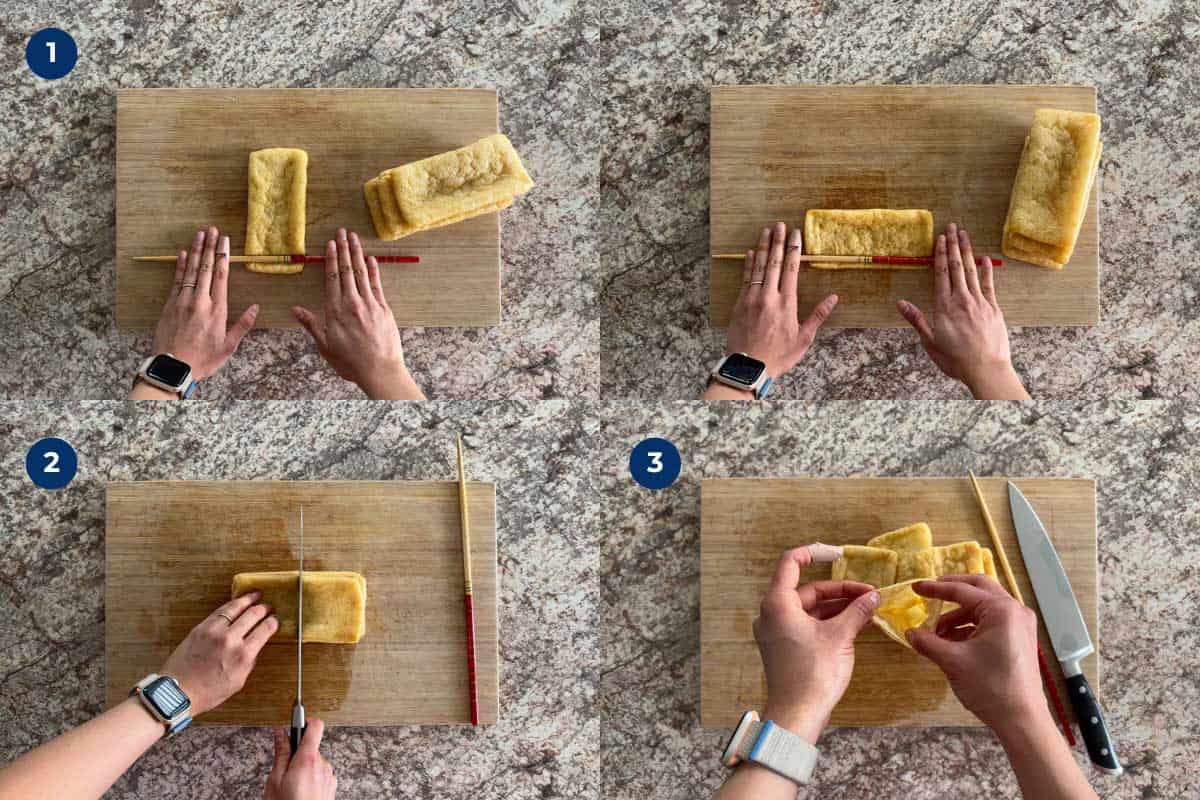
- Gently roll the aburaage with something like a chopstick.
- Cut them in half.
- Open up the pockets.
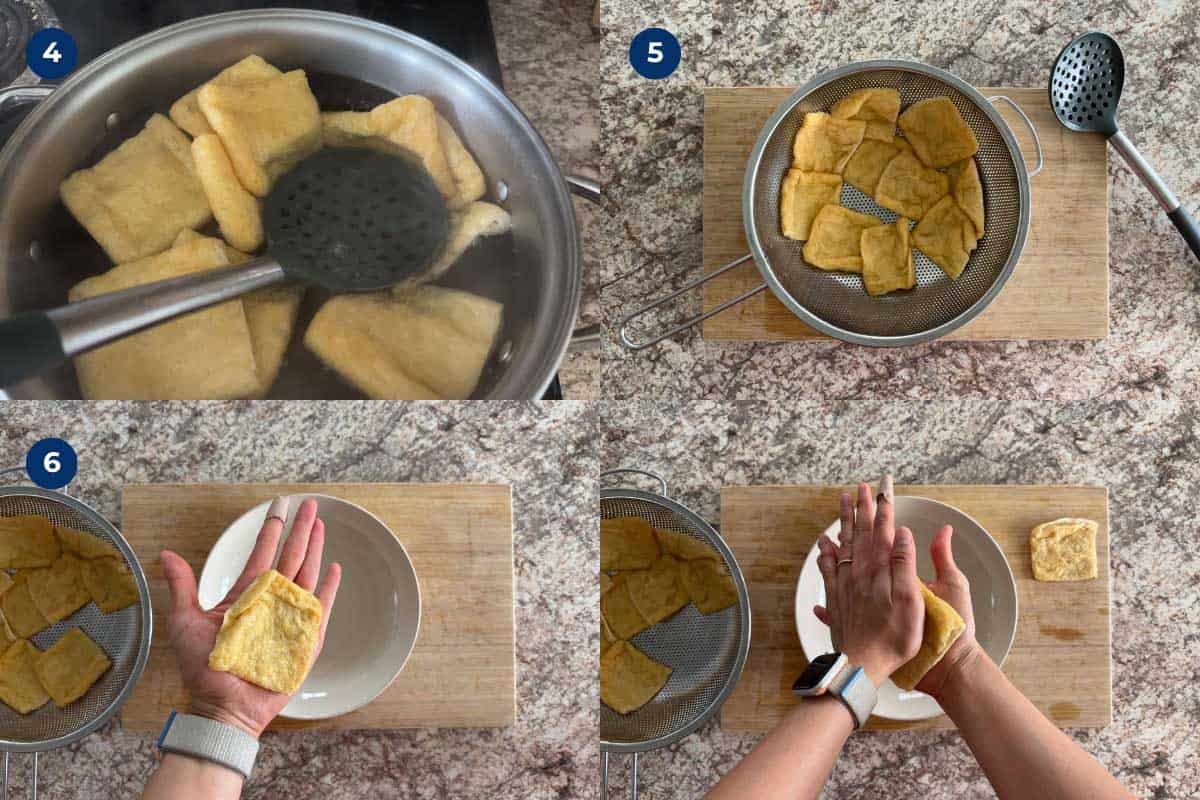
- Boil them for about a minute to remove excess oil.
- Spread the aburaage on a colander and let them cool.
- Gently squeeze each one with your hands.
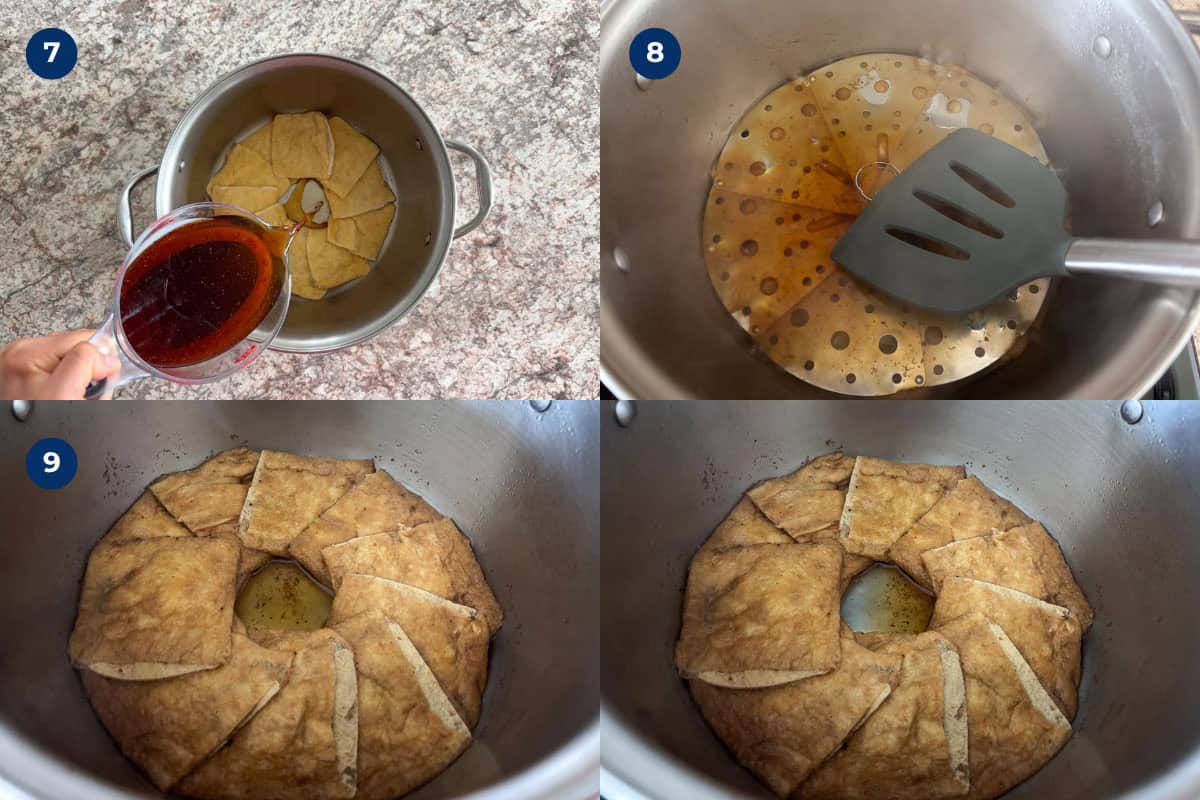
- Arrange them in a radial pattern in a large pot and pour all the broth ingredients in the center.
- Cover with an otoshi buta and simmer for 20 to 25 minutes (press down the otoshi buta about 2 to 3 times).
- Turn off the heat when the amount of remaining broth looks like this (about 0.2 inches deep).
Kurumi's Tips
- Be extra gentle with aburaage: Aburaage can tear easily, so handle it with care, especially when you’re rolling it with a chopstick or squeezing out the moisture.
- Lay the aburaage as flat as possible: When placing them in the pot, try to keep the surface as even as you can. You can make a second layer if needed, but keep everything in a radial pattern so the aburaage cooks and soaks up the seasoning evenly.
- Gently press down the otoshi buta while simmering: This helps the aburaage soak up even more of the broth, giving you extra juicy inari age! (I learned this technique from one of my favorite cooking teachers, Yoko Arimoto)
How to Use Inari Age
Inari age is super versatile and perfect for meal prep, great for throwing together something tasty during busy weekdays!
You can make classic inari sushi by stuffing sushi rice into the pockets, or use them as a topping for udon noodles to make kitsune udon.
They’re also great on their own as a side dish, or you can slice them into strips and mix with rice for a quick mixed rice. Toss them into salads, or add them to eggs for a simple tamago toji, kind of like a lighter, vegetarian version of oyako don.
Storage Instructions
- In the fridge: Once the inari age have cooled, transfer them to an airtight container. Cover with a paper towel and store in the fridge for up to 3 days.
- In the freezer: After they’ve cooled, wrap each inari age in plastic wrap, then place them in an airtight container or freezer bag. They’ll keep in the freezer for up to 3 weeks. When you're ready to use them, just thaw in the fridge for a few hours.
FAQs
Inari age is aburaage (deep-fried tofu pockets) simmered in a sweet and savory broth. It’s commonly used for inari sushi or kitsune udon.
The name "inari" comes from Inari Shrines in Japan, where aburaage was offered to the deity. Over time, people began stuffing the aburaage with rice, and that’s how inari sushi was born!
Not quite. Aburaage is just the plain deep-fried tofu pockets. Inari age is aburaage that has been simmered in a sweet-savory broth. So they’re related, but not the same.
It can be! Just use a vegan-friendly dashi, like kombu dashi, instead of fish-based versions.
You can usually find aburaage in the frozen section of Asian grocery stores or online Asian markets.
More Japanese Side Dish Recipes
Looking for other recipes like this? Try these:
💌 If you tried this recipe and liked it, I’d love to hear from you! Leave a comment and review below or send a photo of your dish to my email. I’d be so happy to see your creation!
📖Recipe

Homemade Inari Age with Maple Syrup (Seasoned Tofu Pockets)
Ingredients
Equipment
Method
- Prep the Aburaage: Start by bringing a large pot of water to a boil. While you wait, gently roll a stick (like a chopstick) over each 5 pieces aburaage to help loosen the fibers. I like to roll from the edges to the center, top to bottom and side to side, on both sides. Then, cut them in half and gently open each one to make sure it forms a pocket. (Not making inari sushi? Feel free to skip the rolling and opening step and just cut them in half.)
- Boil the Aburaage: Once the water is boiling, add the aburaage and boil for about 1 minute to remove excess oil. Keep pressing them down gently so they stay submerged. If you make more than one batch, boil them one batch at a time. When they’re done, transfer them to a colander and lay them out so they don’t overlap. Let them cool until they’re cool enough to touch.
- Squeeze the Aburaage: When they’ve cooled, gently squeeze each one between your palms to remove extra water. Be careful, not too hard, since they can tear easily. Arrange them in a radial pattern in a large pot (you can reuse the one you boiled them in), leaving an open space in the center.
- Simmer the Aburaage: Mix 1 cup dashi, 2 tablespoons maple syrup, and 2 tablespoons soy sauce in a container and pour it into the open space in the center, then place an otoshi buta (drop lid) on top. Turn the heat to medium, and once it comes to a boil, lower it to low to medium-low so it keeps bubbling gently. Let it simmer for about 20 to 25 minutes, or until the bottom of the pot is visible through the broth (about 0.2 inches height). While simmering, gently press down on the otoshi buta to help the aburaage soak up more broth for about 2 to 3 times (see note 3).
- Let it Cool: Once it’s done simmering, turn off the heat and let everything cool in the pot until it comes to room temperature. This helps the aburaage soak up even more flavor.
Notes
- (Note 1) Abburaage: These are deep-fried tofu pockets, usually found in the frozen section at some Asian grocery stores or online Asian markets.
- (Note 2) Dashi: You can use regular liquid dashi, or make your own by mixing 1 cup of water with 1 teaspoon of dashi powder (I like using Kayanoya Dashi).
- (Note 3) Otoshi Buta: You can make a DIY otoshi buta using baking paper. Just cut it into a circle slightly smaller than your pot and poke a few small holes for steam to escape. If you’re using DIY otoshi buta, you can place a small plate on top to gently press down the aburaage while it simmers. Just be sure to remove the plate when you’re not pressing down, so the aburaage don’t get squished too much.
- Storage Instructions: Once the inari age has cooled, transfer it to an airtight container, cover with a paper towel, and store in the fridge for up to 3 days. To freeze, wrap each one in plastic wrap and place them in a freezer-safe container or bag. They’ll keep for up to 3 weeks. When you're ready to use them, just thaw in the fridge for a few hours. Make enough for inari sushi!
📌Pin This Recipe For Later!


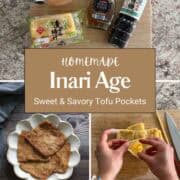

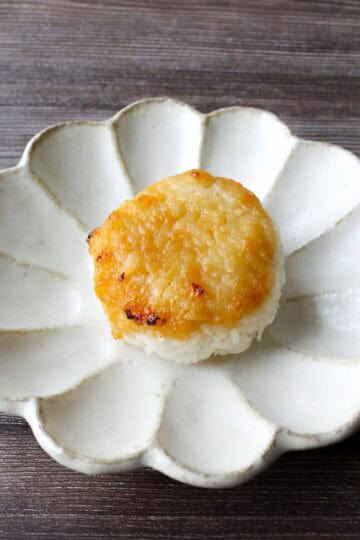
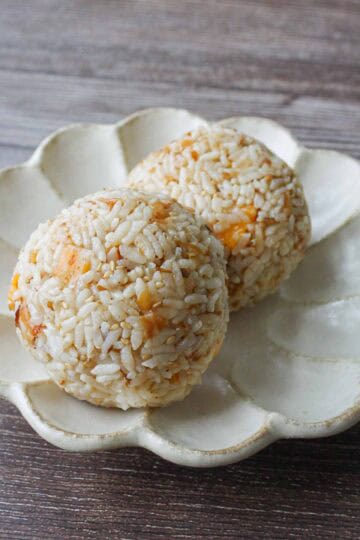
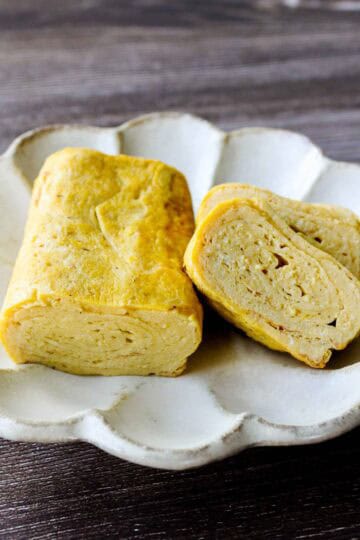
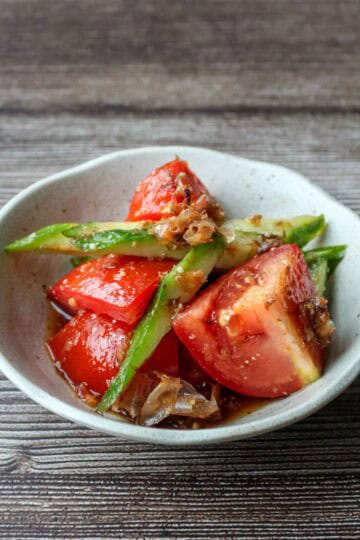
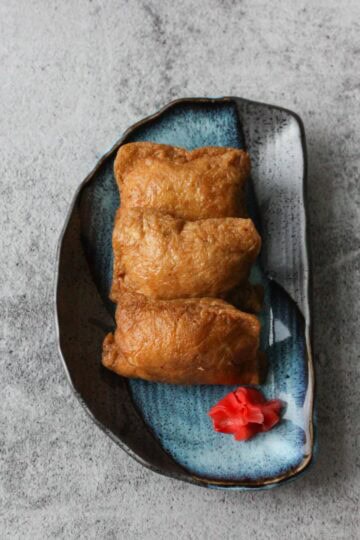

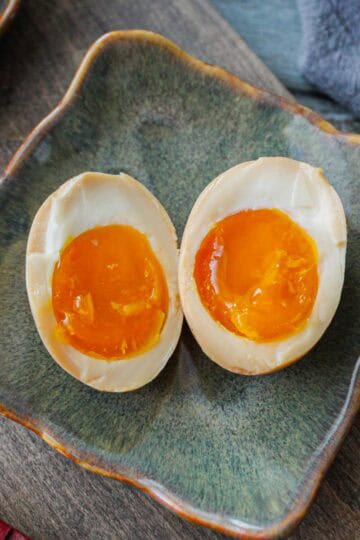
Kurumi says
My mom used to call inari age “oage-san,” and she made it all the time when I was a kid! I loved the juicy, sweet, and savory flavor... I'd happily eat it with just plain rice as a side dish. I’ve come up with my own version that’s really close to her oage-san, but made with maple syrup. I’m so excited to be able to recreate that nostalgic taste here in the States! I hope you’ll love it too. Make a big batch so you’ll have plenty left over for inari sushi later 🙂